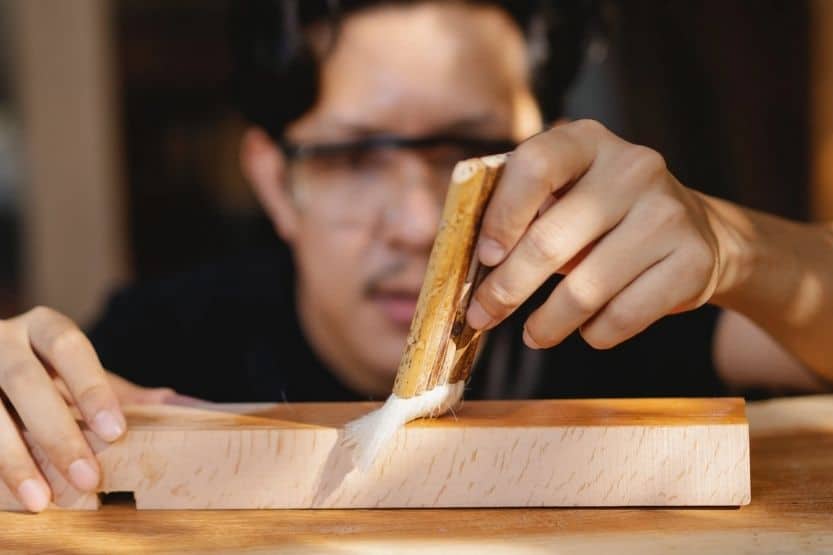Varnish and polyurethane are two popular finishes for wooden boats, furniture, and decks. Knowing the difference between them will help you decide which is best. Varnish vs. polyurethane – what are the differences between them?
Varnish is a mix of oils, resins, and solvents used for indoor and outdoor applications. Varnish is thinner and requires multiple layers. Polyurethane can be water or oil-based, used mostly for indoor applications. Polyurethane is more durable and more expensive.
Read on to learn more about varnish and polyurethane, so you will know which is best for your boat, furniture, or deck.
Varnish vs Polyurethane

From the ease of application to toxicity, polyurethane and varnish are different in many ways. The below table highlights the key differences between varnish and polyurethane:
| VARNISH | POLYURETHANE | |
| COMPOSITION | Made of solvents, oils, and resins | Oil or water-based formula |
| DURABILITY | Less durable | Durable but prone to sun damage |
| USES | Indoor and outdoor applications | Indoor applications |
| SAFETY | Non-toxic but flammable | Water-based is safer than oil-based polyurethane |
| DRYING TIME | Slow-drying, takes about six hours | Water-based polyurethane dries quicker than oil-based |
| APPLICATION | Thin, requires several layers | Thick, requires fewer layers |
| COST | Cheap | Expensive |
Let’s look at the differences in more detail so you can pick which one is more suitable for your wooden boat, deck, or furniture.
Composition
Polyurethane is a liquid coating with an oil or water-based formula. Meanwhile, varnish is made of a combination of solvents, oils, and resins.
Durability
Wood wears out over time due to exposure to the sun, sea, and other external elements. This makes it important to choose a durable finishing material, strengthening the core and withstand harsh environments.
If you want a harder and longer-lasting finish, choose polyurethane. After its application, polyurethane cures and forms a plastic layer on the top of the wood. This layer protects against abrasions and scratches. For a stronger finish, look for oil-based polyurethane.
Uses
Polyurethane and varnish also differ in terms of their uses. For indoor applications, polyurethane is a good choice. The hard polyurethane film splits, cracks, and delaminates with UV exposure. This is the reason why it is not for boat decks and outdoor parts.
Varnish is great for indoor and outdoor applications, even if it is not as durable as polyurethane. It has high solids, making it less susceptible to damage even with constant sun exposure.
Their uses are also different depending on the type of wood. If you will coat softwood, such as pine and cedar, varnish is the best choice. On the other hand, for hardwood, such as alder, mahogany, and birch, it is better to use polyurethane.
Safety
For a safer coating material, choose varnish. While it is non-toxic, take note that it is flammable, especially in its container. It contains resins, plant oils, and synthetic oils, which generate heat when curing. During its application, stay away from combustible materials.
Polyurethane is more toxic than varnish, especially if it is oil-based. A safer alternative is water-based polyurethane, although it is still not as safe as varnish. The toxic effects of polyurethane include headaches, shortness of breath, coughing, and vomiting.
To minimize the safety hazards with the application of wood finishes, proper ventilation is necessary. If possible, do it in an open area. Using oil-based polyurethane, equip yourself with the necessary protection, including a mask to prevent inhaling toxic fumes.
Drying Time
If you want the finish to dry quickly, choose water-based polyurethane. Varnish, on the other hand, dries slowly. With the ideal environment, it will take up to six hours to dry varnish.
Application
Both varnish and polyurethane are easy to apply, which you can do without paying a pro. Varnish is thinner and so will require several coats. Polyurethane is thicker, so you will need fewer layers in its application.
Brushing a varnish is the most common method of application. On the other hand, you can apply polyurethane by wiping, brushing, and spraying.
Cost
Not everyone coating wooden parts of their boat will have the luxury of financial resources. If you are on a budget, varnish is best. On the other hand, if you do not mind spending a bit more, you can go for polyurethane.
While polyurethane is more expensive to purchase, it offers excellent value for the money because it is thick. This means that you won’t require multiple applications, unlike in a varnish.
Watch the video below to know more about the difference between varnish and polyurethane:
All About Varnish
Varnish creates a transparent and hard coating. It naturally has little or no color, but it is often pigmented to achieve different shades.
When buying a varnish, you have to choose a type of finish depending on the look that you want. It can be semi-gloss, gloss, or satin.
It has a high ratio of solids compared to polyurethane. This allows varnish to be less susceptible to sun damage, making it a common outdoor application option.
The flexibility of varnish is one of its best assets, which also sets it apart from polyurethane. It prevents cracking and splitting, even on round surfaces.
Types of Varnishes

If you are thinking of buying varnish to finish wood, below are the most common types you will find:
1. Alkyd Varnish
It has artificial alkyd resin and organic solvent to provide good adhesion. This will create a transparent and solid layer with a slight color.
2. Epoxy Varnish
A combination of organic solvent and epoxy resin is water-resistant and creates a strong bond on wood.
3. Acrylic Varnish
With its water-based formula, this is a non-toxic type. It is versatile since you can use it on other materials, not just wood.
3. Oil Varnish
While it is slow drying, it is the longest-lasting of the types of varnishes. It is a good choice for surfaces that require frequent cleaning and polishing.
How to Apply Varnish
If you decide to use varnish on your wooden boat, furniture, or deck, follow these easy steps:
- Sand wood to prepare it for finishing. For stained wood, use 240 grit sandpaper. If it has no finish, use 100 grit sandpaper.
- Clean the surface after sanding. Otherwise, varnish attracts dust and dirt, which can damage the surface before drying.
- Open the varnish container and stir vigorously. Do not shake from the can. Mix it gently and slowly to avoid bubbles.
- Mix varnish and thinner in preparation for the first coating. Add up to 25% thinner.
- Dip the brush in the varnish and coat the wood lightly. Dip only the tip of the brush. Follow the direction of the grain instead of brushing back and forth.
- Brush up to two more varnish coats, dry, and sand. It is a thin material, so you will need multiple layers to achieve a protective and glossy finish. After six to 24 hours, apply another layer of varnish and wait until it dries.
All About Polyurethane
Polyurethane coating is made of polyols and polyisocyanates. Depending on the manufacturer’s specific formula, it can also contain allophanate, biuret, urea, and urethane.
Popular with hardwood floors, polyurethane protects and seals the wood, creating a hard and abrasion-resistant finishing.
While polyurethane produces a hard and durable film, it delaminates over time, especially with shock and heat. It becomes more vulnerable to damage when it is on softwood, such as pine.
To minimize the susceptibility to damage, priming techniques will help. Using shellac and epoxy will harden the finish to minimize wear.
Types of Polyurethane
When choosing polyurethane coating, you must know the different types available, which indicates its composition.
- One-Component Polyurethane: As the name implies, it uses only one component, making it simple.
- Two-Component Polyurethane: It mixes two components, which usually include a resin and hardener. This is great for protection against chemicals and abrasions.
How to Apply Polyurethane
Coating wood with polyurethane is an easy DIY task. Here’s a quick guide on how you can do this:
- Start by sanding the surface using medium-grit sandpaper. Once done, follow with fine-grit and extra-fine-grit, ensuring that the surface is as smooth as possible. This makes it easier for polyurethane to adhere to the surface. Clean the area after sanding.
- Use a brush with natural bristles, making long and even strokes. You can skip this procedure if you are using a self-sealing polyurethane. Like with a varnish, do not shake the container as this can create bubbles.
- Wait 24 hours for the first coat to dry. Apply long and consistent strokes. Do not wipe the polyurethane from the can’s edge to avoid having bubbles. Overlap the strokes for a more consistent finish.
- Dry the surface for at least 12 hours. If there are any drips, cut them using a blade.
- Sand the surface to get rid of small blemishes. Apply the first coat, dry, and apply a second coat. Repeat if necessary.
Again, what is the difference between marine varnish vs polyurethane? The marine varnish is a mix of oils, solvents, and resins used for indoor and outdoor applications. Varnish is thinner, so it requires multiple layers. Polyurethane can be water or oil-based, used mostly for indoor applications. Polyurethane is more expensive and more durable.
Tips and Tricks for Wood Finishing
Regardless of whether you choose varnish or polyurethane for finishing wood, below are some of the most important things to keep in mind:
- Use an electric sander if you are working in large areas. This will make your job a lot easier and achieve more consistent results. Nonetheless, if you are working on curves, hand-sanding is better.
- Whether you are sanding or coating, use even strokes. This depends on the wood grain, which you should follow. It often starts from the left to the right. Brushing in different directions will negatively impact the final look.
- Look closely at the wood before applying varnish or polyurethane. It is best to use light so that you can spot imperfections. This will let you know what areas need more sanding for a smoother outcome.
- Apply a wood conditioner before coating. It prevents the appearance of dark blotches, which are common in pine, maple, cherry, and birch. The right conditioner will also ensure a more consistent stain.
- Do not ignore the importance of using the right brush. For a water-based material, polyester, nylon, or any synthetic brush is a great option. If you are using an oil-based material, on the other hand, it is best to go for natural bristles.
- If you apply varnish or polyurethane on large areas, it is better to use a pad instead of a brush. This does not only ensure a bigger coverage in a single pass, but it also makes the coating even more.
- Practice using a sample board. This will give you a more realistic idea of how the final finish will look like. If it does not meet your preferences, you can adjust accordingly, using a different stain.
Exploring Other Options for Wood Finishes
While varnish and polyurethane are the most popular options for a wood finish, you can consider other alternatives, including the following:
1. Wax
This is cheap and easy to apply. It creates a shiny appearance but isn’t long-lasting. You will need to reapply often to achieve the finish that you want. It is also quick to remove once you desire another finish.

2. Lacquer
It is a clear coating with a glossy and hard finish. Lacquer offers exceptional substrate protection. It resists damages but prone to scratches and discoloration. Because it is thin, its application is made using a sprayer.
3. Shellac
Made from a combination of a solvent and female lac bug secretion, it adds warm color and a protective finish to the wood. While it is generally durable, chemicals and heat cause damage, such as the appearance of white rings.
Conclusion – Polyurethane vs Varnish
You can use varnish for both indoor and outdoor uses. It is a combination of oils, resins, and solvents. Because it is also thinner, you should apply multiple layers. On the other hand, polyurethane, a more durable and expensive option, can be water or oil-based, used mostly for indoor applications. Polyurethane is more durable and more expensive.
If you are looking for exceptional wood finishes, varnish and polyurethane are some of the best options. The table below quickly summarizes the key differences between the two.
| VARNISH | POLYURETHANE | |
| COMPOSITION | Made of solvents, oils, and resins | Oil or water-based formula |
| DURABILITY | Less durable | Durable but prone to sun damage |
| USES | Indoor and outdoor applications | Indoor applications |
| SAFETY | Non-toxic but flammable | Water-based is safer than oil-based polyurethane |
| DRYING TIME | Slow-drying, takes about six hours | Water-based polyurethane dries quicker than oil-based |
| APPLICATION | Thin, requires several layers | Thick, requires fewer layers |
| COST | Cheap | Expensive |
Start by considering the specific part of the boat you would like to finish. For instance, if you are working on kitchen cabinets and hardwood floors, polyurethane is better. On the other hand, if you are coating a deck or outdoor tables, choose varnish.
It is not enough that you have a high-quality varnish or polyurethane. It is more important that you know the proper application techniques from sanding to maintaining consistent strokes, learn how to finish wood like a pro for the best results.




